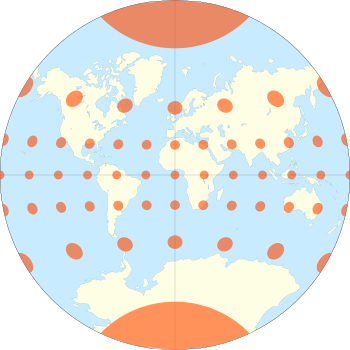| Revision as of 02:41, 16 February 2018 editJustinkunimune (talk | contribs)Extended confirmed users1,972 edits Added Tissot's indicatrices← Previous edit | Revision as of 19:00, 19 August 2018 edit undoWaldyrious (talk | contribs)Administrators20,544 edits →Geometric construction: clarifyNext edit → | ||
| Line 22: | Line 22: | ||
| \end{align}</math> | \end{align}</math> | ||
| If ''φ'' = 0, then | |||
| :<math>\begin{align} x &= \left(\lambda - \lambda_0\right) \\ y &= 0\end{align}</math> | :<math>\begin{align} x &= \left(\lambda - \lambda_0\right) \\ y &= 0\end{align}</math> | ||
Revision as of 19:00, 19 August 2018


The van der Grinten projection is a compromise map projection, which means that it is neither equal-area nor conformal. Unlike perspective projections, the van der Grinten projection is an arbitrary geometric construction on the plane. Van der Grinten projects the entire Earth into a circle. It largely preserves the familiar shapes of the Mercator projection while modestly reducing Mercator's distortion. Polar regions are subject to extreme distortion.
History
Alphons J. van der Grinten invented the projection in 1898 and received US patent #751,226 for it and three others in 1904. The National Geographic Society adopted the projection for their reference maps of the world in 1922, raising its visibility and stimulating its adoption elsewhere. In 1988, National Geographic replaced the van der Grinten projection with the Robinson projection.
Geometric construction
The geometric construction given by van der Grinten can be written algebraically:
where x takes the sign of λ − λ0, y takes the sign of φ and
If φ = 0, then
Similarly, if λ = λ0 or φ = ±π/2, then
In all cases, φ is the latitude, λ is the longitude, and λ0 is the central meridian of the projection.
See also
- List of map projections
- Robinson projection (successor)
References
- ^ Flattening the Earth: Two Thousand Years of Map Projections, John P. Snyder, 1993, pp.258-262, ISBN 0-226-76747-7.
- A Bibliography of Map Projections, John P. Snyder and Harry Steward, 1989, p. 94, US Geological Survey Bulletin 1856.
- Map Projections - A Working Manual, USGS Professional Paper 1395, John P. Snyder, 1987, pp. 239-242.
Bibliography
External links
This cartography or mapping term article is a stub. You can help Misplaced Pages by expanding it. |



